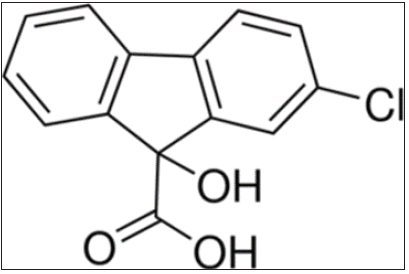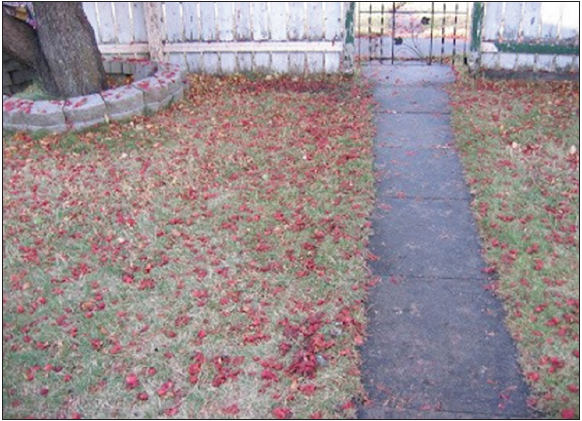- Submissions

Full Text
COJ Technical & Scientific Research
Maintain® CF 125 For Controlling Crabapples
Srinivas Mandava*
Mandava Associates, LLC, 1050 Connecticut Avenue, NW; Suite 500; Washington, DC 20036; USA
*Corresponding author: Srinivas Mandava, Mandava Associates, LLC; 1050 Connecticut Avenue, NW; Suite 500; Washington, DC 20036; USA
Submission: October 21, 2019; Published: November 15, 2019

Volume2 Issue4November, 2019
Abstract
Crabapple trees are commonly grown as ornamental trees. They produce fruit that drop to the ground and create an obstructive mess. In order to prevent fruiting, chlorflurenol is proposed to control fruiting on crab apple trees. Maintain® CF 125 is a formulation of chlorflurenol that is recommended for use as a foliar spray at the time of flower bloom. Crabapple production is significantly reduced at an application rate of 2 pts/100gal. This approach allows the users to enjoy the benefits of the tree while eliminating the nuisance fruit.
Keywords: Crabapple; Chlorflurenol; Ornamental tree; Maintain® CF 125; Plant growth regulators; Fruit control; Chemical thinning
Introduction
Ornamental plants are grown for decorative purposes in gardens and yards. These can
include houseplants, flowers and attractive trees. Ornamental plants commonly require
specific work and pruning to be done by landowners. Many of these plants would cease to be
ornamental if these efforts are not taken such as topiary and bonsai trees. Some species with
aesthetic characteristics are greatly outweighed by the copious amounts of effort to groom
them. With new chemicals and plant growth regulators now widely available, these efforts
can be greatly reduced while still allowing landowners to maintain an attractive landscape.
Crabapple trees are classified as any of several small trees of the genus Malus [1]. They can
vary greatly in size with some only reaching 10 feet in height and others even reaching heights
of 40feet. Crab apple trees mainly grow in the mid-west and north east of the United States.
They are grown for ornamental purposes due to their attractive spring flowers that bloom as
late as April or mid-May and produce small fruits known as crabapples after the flowering
period. The problem with crabapple trees is its fruiting because the flowers can last maybe a
week, but the fruits can last a month or more. Each tree can produce abundance of crabapples.
With the exception of some larger crabapple varieties, the fruits are rarely eaten due to
their sour and bitter taste. The fruits from most crabapple trees are persistent fruit meaning
that they will still hang from the tree even when they are ripe and will eventually drop to the
ground where they create an obstructive mess due to their immediate rotting. This can cause
the area to smell putrid and become an eye sore. Crabapple fruits can also be toxic to pets
and livestock when consumed and can also become a vector for the Coddling moth which are
major pests to agricultural crops. The detrimental effects of these fruits are a determining
factor for landowners to consider the chemical thinning and sterilization of crabapple trees.
Proposed Approach/ Methods
Elimination or thinning of fruit and pollen can inhibit propagation of plant species. This can be done through both mechanical and chemical methods which allow for the survival of the plant but controls the fruiting. Fruit thinning has been practiced throughout history and serves a number of purposes. Too many fruits per tree can result in small fruit size and poor quality, breakage of limbs, exhaustion of tree reserves, and reduced cold hardiness. Chemical thinning is being proposed to control the fruiting of crabapple trees to reduce yard mess for landowners. Hand-removing spent flowers or small fruits will work on a small tree but is not a practical solution for large trees or extensive plantings [2]. Chemical or hormone-type sprays are a more practical method however a concentration that is too low can increase fruit set and excess hormone applications will cause damage to the plant. The described study will illuminate the correct application rate and timing to effectively cull fruit growth in crap apple trees.
Chlorflurenol methyl ester (“Chlorflurenol”) is a member of a group of substances known as morphactins that have the ability to modulate the expression of plants. Morphactins are generally effective in inhibiting seed germination, bud sprouting and growth of seedlings. Chlorflurenol itself operates as an auxin transport inhibitor. It shows strong acropetal movement (movement towards the shoots and fruits) and weak basipetal movement (movement towards the base of roots) which has the benefit of eliminating fruit set while (Figure 1). Allowing the rest of the plant to develop normally. It has also been shown to reduce the size, viability, and germination of pollen which indicates high utility in controlling the propagation of plant species. Chlorflurenol has shown no phytotoxicity so its use is much safer to surrounding wildlife and crops compared to treatments using pesticides such as glyphosate and picloram. The study was conducted over two consecutive years and applied to a healthy crabapple tree. In the first year, Maintain® CF 125 which contains 12.5% of chlorflurenol as active ingredient was applied to the whole tree and in the second year one part of the tree had Maintain® CF 125 applied and the other half of the tree did not and was used as the control.
Figure 1:Chemical Structure for Chlorflurenol.

The crabapple trees were sprayed in the spring of each year at the time of the flower bloom and after full bloom of leaves using the Ortho® Tree & Shrub Spray-Ette (0833810) attached to a ¾” standard water hose. Outdoor weather conditions were on full sunny days with no to minimal winds to prevent any aerial drift. Temperatures were in the mid 50®F. Two pints per 100gal of Maintain® CF 125 were applied to the crabapple tree as a foliar spray. In the first year, the full tree was sprayed in a foliar pattern. In both the years, it was noticed that there was significant reduction the production of the crabapple fruit to the areas of the trees that had Maintain® CF 125 sprayed. In the second year when a control was applied, we noticed that the portion of the tree that had Maintain® CF 125 applied to it had almost an 80-90 % reduction in the crabapple production compared to the control.
Result
During the second year of the study, the crabapple tree was treated as above and also using a control of no treatment for comparison. The pictures and the details of the results are from the second year of the study [3]. The pictures were taken during various phases of the crabapple cycle from early bloom, full bloom and fruiting stage.
Treatment phase
The tree was separated in two parts by a Clear Poly Sheeting- 4Mil, 3x100 as pictured below and treated with Maintain® CF 125 as described in the proposed approach/methods section. The tree is separated from the treated side on the left side of the tree to the untreated right side of the tree (Figure 2-5).
Figure 2:In early spring, when the tree is in the early flowering stage is occurring and prior to treatment, there is full budding in all branches of the tree.

Figure 3:The crabapple tree during the application of Maintain® CF 125.

Figure 4:During the stage of full bloom and after the 1st week of treatment with Maintain® CF 125, the tree has full bloom on all parts of the tree (both treated and untreated parts).

Figure 5:Maintain® CF 125 -treated crabapple tree.

Discussion
Crabapple trees have both ornamental and beneficial properties
for landowners. They can provide shelter and food for birds and
wildlife. In addition, they are important in ecosystems due to their
ability to help pollinate other fruit trees. This is because the pollen
from crab apple trees will pollinate most other variety of apple trees
and fruit trees. In addition, they are able to give insect pollinators
a reliable food source before berries and fruits of other trees
begin to develop. Instead of replacing the plant with non-fruiting
ornamental trees, controlling the fruiting of crabapple trees will
allow for proprietors to enjoy the many benefits along with the
beautiful spring blossoms that this tree provides. Maintain® CF
125 (containing 12.5% chlorflurenol as an active ingredient) is
non- phytotoxic and does not have the potential to harm the target
plant nor the nearby organisms. It has been shown within four to
eight days after application of Maintain® CF 125, residues of the
compound were nonexistent in the soil. No degradation of soil or
side effects of the microflora and physiological processes of the
soil were observed. At a concentration of 12.5% (Maintain® CF
125), applications of Chlorflurenol at bud break have been shown
to inhibit fruit and flower growth in species of ornamental olives,
honeysuckles, ornamental citrus, and many other species.
The use of chlorflurenol allows for the existence of the
crabapple tree for its aesthetic characteristics without the
troublesome fruiting. In addition, it is a much less labor-intensive
means of control as opposed to the common approach of manual
composting or fruit removal by hand. Our recommendation is
an application of Maintain® CF 125 at a rate of 2ptsai/100gal or
higher. This application rate was shown to significantly reduce
fruiting while causing no harm to the tree or surrounding plants.
The formulation of chlorflurenol (Maintain® CF 125) would be a
very effective product to use for the control of crabapple fruiting.
Maintain® CF 125 is the most effective when applied during flower
bloom from April to mid-May. The study that was used in this report
is an introductory study. The amount of fruiting elimination is a
management decision for landowners. The attractive flower bloom
is an incentive for landowners to allow for crabapple trees to grow
on their properties (Figure 6-8).
Figure 6:Untreated tree with full crop of crabapples.

Figure 7:Crabapple tree when it is in full bloom.

Figure 8:When crabapples ripen and drop to the ground, they can cause a huge nuisance for landowners.

Conclusion
It has been shown that a single application of Maintain® CF 125 during the early bloom stage. Each year can significantly reduce the amount of crabapple fruit production. Due to the reduction of the crabapple fruit reduction, the crabapple trees do not present the problem of littering a yard with fruit droppings. Maintain® CF 125 had no other effects on the growth or pollination of the crabapple trees.
References
- https://extension.colostate.edu/topic-areas/yard-garden/flowering-crabapple-trees-7-424/https:/www.e-sciencecentral.org/articles/SC000013800
- http://arnoldia.arboretum.harvard.edu/pdf/articles/2009-67-2-crabapples-with-no-apologies.pdf
- http://runningwithdoggies.blogspot.com/2008/10/oh-yes-its-crab-apple-time-again.html
© 2019 Srinivas Mandava. This is an open access article distributed under the terms of the Creative Commons Attribution License , which permits unrestricted use, distribution, and build upon your work non-commercially.
 a Creative Commons Attribution 4.0 International License. Based on a work at www.crimsonpublishers.com.
Best viewed in
a Creative Commons Attribution 4.0 International License. Based on a work at www.crimsonpublishers.com.
Best viewed in 







.jpg)






























 Editorial Board Registrations
Editorial Board Registrations Submit your Article
Submit your Article Refer a Friend
Refer a Friend Advertise With Us
Advertise With Us
.jpg)






.jpg)














.bmp)
.jpg)
.png)
.jpg)










.jpg)






.png)

.png)



.png)






